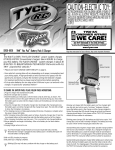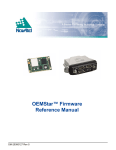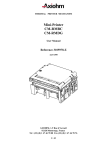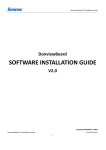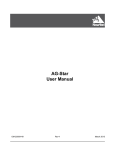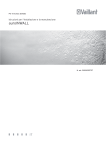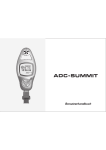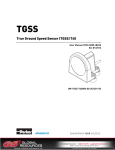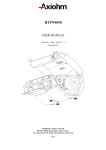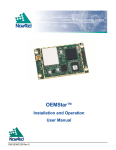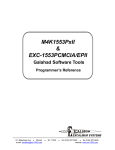Download Application Program Interface (API)
Transcript
OEMSTAR
Application Program
Interface (API)
USER GUIDE
OM-20000131
Rev 1
Proprietary Notice
OEMSTAR Application Program Interface (API) User Guide
Publication Number:
OM-20000131
Revision Level:
1
Revision Date:
2012/2/2
Proprietary Notice
The software described in this document is furnished under a licence agreement or non-disclosure
agreement. The software may be used or copied only in accordance with the terms of the agreement. It is
against the law to copy the software on any medium except as specifically allowed in the license or nondisclosure agreement.
No part of this manual may be reproduced or transmitted in any form or by any means, electronic or
mechanical, including photocopying and recording, for any purpose without the express written permission
of a duly authorized representative of NovAtel Inc.
The information contained within this manual is believed to be true and correct at the time of publication.
OEMStar and FlexPak are trademarks of NovAtel Inc.
NovAtel® is a registered trademark of NovAtel Inc.
All other brand names are trademarks of their respective holders.
© Copyright 2012 NovAtel Inc. All rights reserved
Unpublished rights reserved under International copyright laws.
Printed in Canada on recycled paper. Recyclable.
2
OEMStar Application Program Interface (API) User Guide Rev 1
Table of Contents
Software License
Warranty Policy
Foreword
5
7
8
Scope .......................................................................................................................................8
Conventions .............................................................................................................................8
Customer Support ....................................................................................................................8
1 Introduction
9
1.1 Overview .............................................................................................................................9
1.2 Features ..............................................................................................................................9
1.3 Requirements to Build and Run an Application ...................................................................9
1.3.1 Firmware Compatibility ..............................................................................................9
1.4 Materials Provided.............................................................................................................10
2 Designing and Building the Application
11
2.1 Designing the Application ..................................................................................................11
2.1.1 Working with the Virtual Ports..................................................................................11
2.1.2 Using the GPIOs ......................................................................................................11
2.1.3 Input Parameters .....................................................................................................12
2.1.4 Auto-Start Applications ............................................................................................12
2.2 Building the Application .....................................................................................................13
2.2.1 Building the Application Using a Supported Compiler .............................................13
2.2.2 Converting Binary to S-Records ..............................................................................13
2.2.3 Adding Information for Loading the Application .......................................................15
2.2.4 Automating Utility Execution ....................................................................................17
3 Loading and Controlling the Application
19
3.1 Setting up the Receiver .....................................................................................................19
3.1.1 Determining the Current Model and Firmware Version............................................19
3.1.2 Updating the Firmware.............................................................................................20
3.1.3 Authorizing a Model with the API Option .................................................................20
3.2 Loading the Application .....................................................................................................20
3.3 Controlling the Application.................................................................................................21
3.3.1 Starting the Application ............................................................................................21
3.3.2 Stopping the Application ..........................................................................................22
3.3.3 Removing the Application ........................................................................................22
4 Additional Information
23
4.1 Determining the Version of the Loaded Application ..........................................................23
4.2 Logging the Application Status ..........................................................................................23
4.3 DATABLK Parameters Used in Logs ................................................................................25
4.4 Determining the Version of WinLoad.................................................................................25
A Technical Specifications
OEMStar Application Program Interface (API) User Guide Rev 1
26
3
Tables
S-Record Fields............................................................................................................... 14
S-Record Types............................................................................................................... 14
DATABLK Parameters..................................................................................................... 15
APPLICATION START Parameters ................................................................................ 21
DATABLK Parameters Used in Logs............................................................................... 25
OEMStar GPIO Electrical Specifications ......................................................................... 26
FlexPak-G2 with OEMStar GPIO Electrical Specifications.............................................. 26
4
OEMStar Family Application Program Interface (API) User Guide Rev 1
Software License
Software License
BY INSTALLING, COPYING, OR OTHERWISE USING THE SOFTWARE PRODUCT, YOU AGREE
TO BE BOUND BY THE TERMS OF THIS AGREEMENT. IF YOU DO NOT AGREE WITH THESE
TERMS OF USE, DO NOT INSTALL, COPY OR USE THIS ELECTRONIC PRODUCT (SOFTWARE,
FIRMWARE, SCRIPT FILES, OR OTHER ELECTRONIC PRODUCT WHETHER EMBEDDED IN THE
HARDWARE, ON A CD OR AVAILABLE ON THE COMPANY WEB SITE) (hereinafter referred to as
"Software").
1. License: NovAtel Inc. ("NovAtel") grants you a non-exclusive, non-transferable license (not a sale)
to, where the Software will be used on NovAtel supplied hardware or in conjunction with other NovAtel
supplied software, use the Software with the product(s) as supplied by NovAtel. You agree not to use
the Software for any purpose other than the due exercise of the rights and licences hereby agreed to
be granted to you.
2. Copyright: NovAtel owns, or has the right to sublicense, all copyright, trade secret, patent and other
proprietary rights in the Software and the Software is protected by national copyright laws, international
treaty provisions and all other applicable national laws. You must treat the Software like any other copyrighted material except that you may make one copy of the Software solely for backup or archival purposes (one copy may be made for each piece of NovAtel hardware on which it is installed or where
used in conjunction with other NovAtel supplied software), the media of said copy shall bear labels
showing all trademark and copyright notices that appear on the original copy. You may not copy the
product manual or written materials accompanying the Software. No right is conveyed by this Agreement for the use, directly, indirectly, by implication or otherwise by Licensee of the name of NovAtel, or
of any trade names or nomenclature used by NovAtel, or any other words or combinations of words
proprietary to NovAtel, in connection with this Agreement, without the prior written consent of NovAtel.
3. Patent Infringement: NovAtel shall not be liable to indemnify the Licensee against any loss sustained by it as the result of any claim made or action brought by any third party for infringement of any
letters patent, registered design or like instrument of privilege by reason of the use or application of the
Software by the Licensee or any other information supplied or to be supplied to the Licensee pursuant
to the terms of this Agreement. NovAtel shall not be bound to take legal proceedings against any third
party in respect of any infringement of letters patent, registered design or like instrument of privilege
which may now or at any future time be owned by it. However, should NovAtel elect to take such legal
proceedings, at NovAtel's request, Licensee shall co-operate reasonably with NovAtel in all legal
actions concerning this license of the Software under this Agreement taken against any third party by
NovAtel to protect its rights in the Software. NovAtel shall bear all reasonable costs and expenses
incurred by Licensee in the course of co-operating with NovAtel in such legal action.
4. Restrictions: You may not:
(a)
copy (other than as provided for in paragraph 2), distribute, transfer, rent, lease, lend, sell or
sublicense all or any portion of the Software except in the case of sale of the hardware to a
third party;
(b)
modify or prepare derivative works of the Software;
(c)
use the Software in connection with computer-based services business or publicly display
visual output of the Software;
(d)
transmit the Software over a network, by telephone or electronically using any means (except
when downloading a purchased up[grade from the NovAtel Web site); or
(e)
reverse engineer, decompile or disassemble the Software.
You agree to keep confidential and use your best efforts to prevent and protect the contents of the Software from unauthorized disclosure or use.
OEMStar Family Application Program Interface (API) User Guide Rev 1
5
Software License
5. Term and Termination: This Agreement and the rights and licences hereby granted shall continue
in force in perpetuity unless terminated by NovAtel or Licensee in accordance herewith. In the event
that the Licensee shall at any time during the term of this Agreement: i) be in breach of its obligations
hereunder where such breach is irremediable or if capable of remedy is not remedied within 30 days of
notice from NovAtel requiring its remedy; then and in any event NovAtel may forthwith by notice in writing terminate this Agreement together with the rights and licences hereby granted by NovAtel.
Licensee may terminate this Agreement by providing written notice to NovAtel. Upon termination, for
any reasons, the Licensee shall promptly, on NovAtel's request, return to NovAtel or at the election of
NovAtel destroy all copies of any documents and extracts comprising or containing the Software. The
Licensee shall also erase any copies of the Software residing on Licensee's computer equipment. Termination shall be without prejudice to the accrued rights of either party, including payments due to
NovAtel. This provision shall survive termination of this Agreement howsoever arising.
6. Warranty: NovAtel does not warrant the contents of the Software or that it will be error free. The
Software is furnished "AS IS" and without warranty as to the performance or results you may obtain by
using the Software. The entire risk as to the results and performance of the Software is assumed by
you. See product enclosure, if any for any additional warranty.
7. Indemnification: NovAtel shall be under no obligation or liability of any kind (in contract, tort or otherwise and whether directly or indirectly or by way of indemnity contribution or otherwise howsoever) to
the Licensee and the Licensee will indemnify and hold NovAtel harmless against all or any loss, damage, actions, costs, claims, demands and other liabilities or any kind whatsoever (direct, consequential,
special or otherwise) arising directly or indirectly out of or by reason of the use by the Licensee of the
Software whether the same shall arise in consequence of any such infringement, deficiency, inaccuracy, error or other defect therein and whether or not involving negligence on the part of any person.
8. Disclaimer and Limitation of Liability:
(a)
THE WARRANTIES IN THIS AGREEMENT REPLACE ALL OTHER WARRANTIES,
EXPRESS OR IMPLIED, INCLUDING ANY WARRANTIES OF MERCHANTABILITY OR
FITNESS FOR A PARTICULAR PURPOSE. NovAtel DISCLAIMS AND EXCLUDES ALL
OTHER WARRANTIES. IN NO EVENT WILL NovAtel's LIABILITY OF ANY KIND
INCLUDE ANY SPECIAL, INCIDENTAL OR CONSEQUENTIAL DAMAGES, INCLUDING
LOST PROFITS, EVEN IF NovAtel HAS KNOWLEDGE OF THE POTENTIAL LOSS OR
DAMAGE.
(b)
NovAtel will not be liable for any loss or damage caused by delay in furnishing the Software or
any other performance under this Agreement.
(c)
NovAtel's entire liability and your exclusive remedies for our liability of any kind (including liability for negligence) for the Software covered by this Agreement and all other performance or
non-performance by NovAtel under or related to this Agreement are to the remedies specified
by this Agreement.
9. Governing Law: This Agreement is governed by the laws of the Province of Alberta, Canada. Each
of the parties hereto irrevocably attorns to the jurisdiction of the courts of the Province of Alberta.
10. Customer Support: For Software UPDATES and UPGRADES, and regular customer support, contact the NovAtel GPS Hotline at 1-800-NOVATEL (U.S. or Canada only), or +1-403-295-4900, Fax +1403-295-4901, e-mail to [email protected],
Web site: http://www.novatel.com or write to:
NovAtel Inc.
Customer Support Department
1120 - 68 Avenue NE,
Calgary, Alberta, Canada T2E 8S5
6
OEMStar Family Application Program Interface (API) User Guide Rev 1
Warranty
Warranty Policy
NovAtel Inc. warrants that its Global Positioning System (GPS) products are free from defects in materials and
workmanship, subject to the conditions set forth below, for the following periods of time:
OEMStar Receiver Cards
OEMStar-Based Receivers
NovAtel Antennas
Cables and Accessories
Software Support
One (1) Year
One (1) Year
One (1) Year
Ninety (90) Days
One (1) Year
Date of sale shall mean the date of the invoice to the original customer for the product. NovAtel’s responsibility
respecting this warranty is solely to product replacement or product repair at an authorized NovAtel location only.
Determination of replacement or repair will be made by NovAtel personnel or by technical personnel expressly
authorized by NovAtel for this purpose.
THE FOREGOING WARRANTIES DO NOT EXTEND TO (I) NONCONFORMITIES, DEFECTS OR
ERRORS IN THE PRODUCTS DUE TO ACCIDENT, ABUSE, MISUSE OR NEGLIGENT USE OF
THE PRODUCTS OR USE IN OTHER THAN A NORMAL AND CUSTOMARY MANNER, ENVIRONMENTAL CONDITIONS NOT CONFORMING TO NOVATEL’S SPECIFICATIONS, OR FAILURE TO FOLLOW PRESCRIBED INSTALLATION, OPERATING AND MAINTENANCE
PROCEDURES, (II) DEFECTS, ERRORS OR NONCONFORMITIES IN THE PRODUCTS DUE TO
MODIFICATIONS, ALTERATIONS, ADDITIONS OR CHANGES NOT MADE IN ACCORDANCE
WITH NOVATEL’S SPECIFICATIONS OR AUTHORIZED BY NOVATEL, (III) NORMAL WEAR
AND TEAR, (IV) DAMAGE CAUSED BY FORCE OF NATURE OR ACT OF ANY THIRD PERSON,
(V) SHIPPING DAMAGE; OR (VI) SERVICE OR REPAIR OF PRODUCT BY THE DEALER WITHOUT PRIOR WRITTEN CONSENT FROM NOVATEL. IN ADDITION, THE FOREGOING WARRANTIES SHALL NOT APPLY TO PRODUCTS DESIGNATED BY NOVATEL AS BETA SITE TEST
SAMPLES, EXPERIMENTAL, DEVELOPMENTAL, PREPRODUCTION, SAMPLE, INCOMPLETE
OR OUT OF SPECIFICATION PRODUCTS OR TO RETURNED PRODUCTS IF THE ORIGINAL
IDENTIFICATION MARKS HAVE BEEN REMOVED OR ALTERED. THE WARRANTIES AND
REMEDIES ARE EXCLUSIVE AND ALL OTHER WARRANTIES, EXPRESS OR IMPLIED, WRITTEN OR ORAL, INCLUDING THE IMPLIED WARRANTIES OF MERCHANTABILITY OR FITNESS FOR ANY PARTICULAR PURPOSE ARE EXCLUDED. NOVATEL SHALL NOT BE LIABLE
FOR ANY LOSS, DAMAGE, EXPENSE, OR INJURY ARISING DIRECTLY OR INDIRECTLY OUT
OF THE PURCHASE, INSTALLATION, OPERATION, USE OR LICENSING OR PRODUCTS OR
SERVICES. IN NO EVENT SHALL NOVATEL BE LIABLE FOR SPECIAL, INDIRECT, INCIDENTAL OR CONSEQUENTIAL DAMAGES OF ANY KIND OR NATURE DUE TO ANY CAUSE.
There are no user serviceable parts in the GPS receiver and no maintenance is required. When the status code
indicates that a unit is faulty, replace with another unit and return the faulty unit to NovAtel Inc.
Before shipping any material to NovAtel or Dealer, please obtain a Return Material Authorization (RMA)
number by calling NovAtel Customer Support at 1-800-NOVATEL in North America or 1-403-295-4900
elsewhere.
Once you have obtained an RMA number, you will be advised of proper shipping procedures to return any
defective product. When returning any product to NovAtel, please return the defective product in the original
packaging to avoid shipping damage.
OEMStar Family Application Program Interface (API) User Guide Rev 1
7
Foreword
Scope
Foreword
This document contains sufficient information on working with the Application Program Interface
(API) to be able to develop applications for NovAtel’s OEMStar receivers. It does not provide specific
details of the functions offered by the API, but rather information on building and loading
applications. Details of the API functions can be found in the API header file.
Conventions
The conventions used throughout this document are:
< >
Text displayed between < and > indicates a variable parameter.
[ ]
Text displayed between [ and ] indicates an optional parameter
This is a notebox that contains important additional information.
In tables where no values are given, such fields should be assumed to be reserved for future use.
Customer Support
If you have any questions or concerns regarding the OEMStar API, use one of the following methods
to contact NovAtel Customer Support:
Call the NovAtel Hotline at 1-800-NOVATEL (U.S. & Canada)
or +1-403-295-4900 (international)
Fax: +1-403-295-4901
E-mail: [email protected]
Web site: http://www.novatel.com
8
Write: NovAtel Inc.
Customer Support Department
1120 - 68 Avenue NE
Calgary, AB
Canada, T2E 8S5
OEMStar Family Application Program Interface (API) User Guide Rev 1
Chapter 1
1.1
Introduction
Overview
The Application Program Interface (API) allows you to develop specialized C/C++ applications to
further extend the functionality of your OEMStar receiver. By using the functions provided by the
API, along with the commands and logs already provided by the OEMStar, a wide variety of
applications can be created.
1.2
Features
The OEMStar API provides the following features:
•
The ability to open physical ports on the receiver to interface with external devices
•
Support for three virtual ports, allowing you to directly send commands to and receive
logs from the receiver firmware
•
Support for multiple tasks, with varying priority levels
•
Message queuing functionality
•
Support for semaphores and mutexes
•
The ability to control many of the receiver’s general purpose input/output (GPIO) lines
•
Access to receiver time
•
Pulse-width modulation control (for receivers that support it)
Refer to the API header file for more information on the features provided by the API.
1.3
Requirements to Build and Run an Application
In addition to the items listed in the API Development Kit (see Section 1.4), the following is required
to develop and run an application on an OEMStar receiver:
1.3.1
•
A NovAtel supported compiler. Currently, Green Hills Software C/C++ compilers are
supported. The Green Hills Software C/C++ compiler is available in the Green Hills
Multi 2000 Integrated Development Environment.
•
OEMStar receiver loaded with an API enabled software model (See Section 3.1 on page
19 for more information about setting up the receiver for loading an application.)
•
PC with a serial port and a serial cable to load the application on to the receiver
•
OEMStar Firmware Reference Manual
Firmware Compatibility
Firmware support for the API has been designed for backwards compatibility. For example, if the
firmware loaded on to the receiver supports version 15 of the API, an application built using version
14 of the API will execute correctly. However, if the application uses a newer version of the API than
OEMStar Application Program Interface (API) User Guide Rev 1
9
the firmware supports, the additional or updated functionality provided by the API may not be
available.
A description of the changes made to the API since the last version can be found at the beginning of
the API header file. To determine what version of the API your firmware supports, log the
APPLICATIONSTATUS message, which is described further in Section 4.2 on page 23.
Compiler compatibility has been tested successfully up to Green Hills Multi V4.2.4. You must run
OEMStar firmware version 1.100 or higher.
The API library and header files are named with the firmware version. For example:
L6X010100RN0000.api.a.
1.4
Materials Provided
As part of the OEMStar API Development Kit, the following is provided:
10
•
An OEMStar API library file (OEMStar_api.a)
•
An OEMStar API header file (OEMStar_api.h)
•
One sample project for the Greenhills Multi
•
Two Windows command line utility programs, TOSREC and DATABLK, which format
the executable for use with a NovAtel receiver
•
NovAtel’s WinLoad utility for loading the application on to the receiver
OEMStar Application Program Interface (API) User Guide Rev 1
Chapter 2
2.1
Designing and Building the Application
Designing the Application
When designing an application for an OEMStar receiver, it is important to have an understanding of
some of the key features of the API, which are explained in the sections below.
Review the sample application provided with the API for more information on how to design
your application to work with the receiver firmware.
2.1.1
Working with the Virtual Ports
When communicating through one of the physical or virtual ports, the application must be designed to
either:
•
Read all data sent to the port, or
•
Configure the port to not transmit data and disable response generation
This is necessary because any incoming data will remain in a buffer until it is read and will not be
automatically discarded if more data arrives, resulting in a build up of waiting data.
To disable transmission and response generation at the port, use the INTERFACEMODE command
with the NONE mode for the txtype field and OFF for the responses field. Refer to the OEMStar
Firmware Reference Manual for more information on this command.
2.1.2
Using the GPIOs
The OEMStar receiver provides LV-TTL general-purpose input/output (GPIO) signals that can be
used by your application. The API header file provides more details on the functions available to
control and read these GPIOs. The sections below indicate which GPIOs are provided and Section A.1
on page 26 gives the electrical specifications for those GPIOs.
2.1.2.1
OEMStar
The following GPIO pins available on the OEMStar:
•
•
•
•
GPIO0
GPIO1
GPIO3
PV (output only)
See Pin-Outs on page 27 for additional information.
OEMStar Family Application Program Interface (API) User Guide Rev 1
11
2.1.2.2
FlexPak-G2 with OEMStar
There are two GPIO pins available on the FlexPak-G2 with OEMStar:
•
PV
•
GPIO1
The OEMStar Installation and Operation User Manual provides the location of this pin and details of
internal pull-up or pull-down resistors. The electrical specifications for this pin are given in Table 7 on
page 26
Note: For OEMStar, Pin 5 = PV line and Pin 6 = GPIO1 line.
2.1.3
Input Parameters
There are two methods that can be used to pass parameters to an application, as discussed in the
following sections.
2.1.3.1
Command-Line Entry
The application can be designed to accept a single unsigned, 32-bit parameter, which is then entered
as part of the command string for starting the application. This parameter could be used, for example,
to set the output serial port used by the application.
For more information about entering a parameter when starting the application, see Section 3.3.1 on
page 21.
See Section 2.1.4 for a note about the use of command-line entry input parameters with auto-start
applications.
2.1.3.2
DATABLK Entry
Alternately, the <SNKey> field, set when the DATABLK utility is run on the executable, can be used
to store an input parameter, which would then be read from the VERSION log by the application.
For more information about the <SNKey> field, see Section 2.2.3.1 on page 15. Section 4.3 on page
25 provides more information about where the field is stored in the VERSION log.
2.1.4
Auto-Start Applications
An application loaded on to an OEMStar receiver can be set to automatically start whenever the
receiver is powered up. This option is set using the <ComponentEnum #> field of the DATABLK
utility, which is described in Section 2.2.3 on page 15.
12
OEMStar Family Application Program Interface (API) User Guide Rev 1
When an application is configured to automatically start, the input parameter is fixed as 0, the
priority is set to 1, and the stack size is 10,000. See Section 3.3 on page 21 for more
information.
2.2
Building the Application
Building the application in a format that can be loaded on to a receiver is a three step process:
1. Build the application using one of the supported compilers.
2. Convert the binary executable to S-records.
3. Add the S-records necessary for loading the application.
Each of these steps is discussed in the sections that follow.
2.2.1
Building the Application Using a Supported Compiler
2.2.1.1
Project Configuration
With the Greenhills version 4.2.4 compiler, use the build file provided with the sample application as
a template. This build file has the necessary settings for a variety of options, including the application
format and target, which should not be altered. However, the following can be changed to customize
the project, either by directly editing the file or using the interface provided by the compiler.
2.2.2
•
The name of the output file
•
The files included in the project
Converting Binary to S-Records
When loading the application on to the receiver, the S-record format, which is described in Section
2.2.2.1, is used. Therefore, once the application has been built, the resulting binary ELF file must be
converted to S-record format. The TOSREC utility is provided to complete this conversion.
2.2.2.1
S-Records
The S-record format is an industry standard for encoding programs or data files in a printable form
that allows for ease of transfer between devices.
An S-record is an ASCII character string consisting of five fields, in the format shown below.
<type><length><address><data...><checksum>
The S-record fields all use hexadecimal format, except for the <type> field. The fields are described
in Table 1 below.
OEMStar Family Application Program Interface (API) User Guide Rev 1
13
Table 1: S-Record Fields
Field
Length
(Characters)
Description
<type>
2
The type of S-record, as described by Table 2.
<length>
2
The number of character pairs in the record,
excluding the <type> and <length> fields.
<address>
4, 6, or 8
The 2, 3, or 4-byte address at which to load the
contents of the data field in memory.
<data>
variable
Executable code or memory-loadable data.
The least significant byte of the one’s complement
of the sum of the values represented by the length,
the address, and the data fields.
2
<checksum>
There are 3 types of S-records used for OEMStar applications, as shown in Table 2 below.
Table 2: S-Record Types
Type
Description
S0
Header record. Used by WinLoad to determine how to load the
application as described in Section 2.2.3.2 on page 17
S3
Data record
S7
End-of-file record
Typically, each S-record file consists of one or more header records, followed by one or more data
records, concluded with a single end-of-file record.
2.2.2.2
Using TOSREC
The TOSREC utility is a Windows command line program. To run the application, enter the following
in a command window:
tosrec <infile>
where <infile> is the name of the file to be converted. The name of the S-record file to be
generated can be specified using the following option trigger:
-o <outfile>
where <outfile> is the name of the output file.
Examples of command strings to run the utility are given below.
tosrec input.elf
tosrec input.elf -o output.hex
14
OEMStar Family Application Program Interface (API) User Guide Rev 1
2.2.3
Adding Information for Loading the Application
The WinLoad utility, which is used to load the application on to the receiver, reads information from
the input file in order to determine how the application should be loaded. This information is included
in a special set of S-records placed at the beginning of the file. Once the application data has been
converted to an S-record format, the DATABLK utility is used to add these necessary records.
2.2.3.1
Using DATABLK
The DATABLK utility is a Windows command line program. To run the application, enter the
following string in a command window.
datablk <In SREC File> <Out SREC File> <Compress> <Block #>
<ComponentEnum #> <Name> <Version> <SNKey> <Platform> [Compile
Date] [Compile Time]
Each of the parameters are described in the table below.
Table 3: DATABLK Parameters
Parameter
Valid Values
Description
<In SREC File>
Any
File name of input file.
<Out SREC File>
Any
File name of output file.
<Compress>
Compress or
Raw
Specifies whether or not the data will be
compressed.
<Block #>
0
The data block in memory in which the
application will be loaded into.
<ComponentEnum #>
1 or 5
The type of application, where 1 specifies
a standard user application and 5 specifies
an auto-starting user application.
<Name>
14 non-null characters or less
A string indicating the name of the
application
<Version>
14 non-null characters or less
A string indicating the version of the
application.
<SNKey>
14 non-null characters or less
A string indicating the serial number or key
for the application. Can also be used to set
an application parameter. See Section
2.1.3.2 on page 12 for more details.
<Platform>
14non-null characters or less
A string of comma separated platforms the
application is targeting. For OEMStar,
valid options are M6XV1G and M6XV1.
OEMStar Family Application Program Interface (API) User Guide Rev 1
15
Parameter
Valid Values
Description
[Compile Date]
Any valid date in the format
yyyy/mmm/dd, where mmm is
three letters for the month (eg.
JAN)
Optional field to specify the date the
application was compiled. If no value is
provided, the PC’s current date will be
used.
[Compile Time]
Any valid time in the format
hh:mm:ss
Optional field to specify the time the
application was compiled.If no value is
provided, the PC’s current time will be
used.
An example command string to run the utility is given below.
datablk input.hex output.hex raw 2 1 SampleApp 1.00 1234
M6XV1G
See Section 4.3 on page 25 for more information about how the values entered for the DATABLK
parameters are used in the receiver logs.
16
OEMStar Family Application Program Interface (API) User Guide Rev 1
2.2.3.2
Records Used By WinLoad
DATABLK adds three header records that are required by the WinLoad utility when loading the
application. The records provide the following information to WinLoad:
2.2.4
•
The target platform of the OEMStar receiver (M6XV1 and/or M6V1G)
•
The version of the application
•
In which data block to load the application (block 0)
Automating Utility Execution
The Greenhills Multi development environment supports execution of specified programs after
compilation. This feature can be used to automate execution of TOSREC and DATABLK. By doing
so, the binary executable will automatically be converted to S-records and the necessary records for
loading will be added. The resultant executable can be loaded directly on to the receiver without
further manipulation. Please see below if you are developing with Greenhills Multi.
To automate this, with the project open in Multi, select Set Options... from the Edit menu.
OEMStar Family Application Program Interface (API) User Guide Rev 1
17
Expand the Advance option under the Option Categories on the left side of the window.
Click on Advanced Project Options under the Option Categories on the left side of the window.
On the right side of the window, under Build Options in Category, double-click on Commands to
Execute After Associated Command.
In the Commands to Execute After Associated Command box, enter the command strings to run the
utilities.
Press OK to save the changes.
The next time the application is built, the utilities will automatically be executed as specified.
18
OEMStar Family Application Program Interface (API) User Guide Rev 1
Chapter 3
Loading and Controlling the Application
Once the application has been built and converted to S-record format, with the necessary S-records
added, the application can be loaded on to the receiver.
A Windows-based utility named WinLoad has been created to assist with loading the firmware.
3.1
Setting up the Receiver
In order to load and run an application, the receiver must have:
•
A model with the API option enabled, and
•
Version L6X010101RN0000 or higher of firmware loaded
The following sections provide information on how to determine if your receiver meets these criteria
and how to update it if it does not.
3.1.1
Determining the Current Model and Firmware Version
To determine the current model and firmware version of the receiver, read the VERSION log. To do
so, send the following command to the receiver.
LOG VERSION
Read the output provided, specifically the 1st and 4th fields after the word GPSCARD. The first field
provides the model and the fourth field indicates the version of firmware loaded on the receiver. In the
example below, the model is “LXGMTSA” and the firmware version field shows
“L6X010101RN0000”.
<VERSION COM1 0 68.0 UNKNOWN 0 5.263 004c0000 3681 6576
<2
< GPSCARD "LXGMTSA" "BHD09320088" "M6XV1G-4.00-TT" "L6X010101RN0000" "L6XD10004DBG004"
"2011/Mar/02" "12:15:06"
< DB_USERAPP "datalogdisplay" "0" "" "1.000" "" "2012/Feb/01" "13:50:42"
GPS card field
Model field
Firmware version field
In this example, the model field ends with an “A” and the firmware version field reads
“L6X010101RN0000” therefore, an application can be loaded on to the receiver. If an update to the
firmware and/or model is needed, instructions are provided in Section 3.1.2 and Section 3.1.3.
OEMStar Family Application Program Interface (API) User Guide Rev 1
19
3.1.2
Updating the Firmware
To update the firmware to a version that supports the API, obtain the following from NovAtel
Customer Support.
•
The firmware update file, with version 1.100 or higher
•
An update authorization code
WinLoad is also required to load the firmware on to the receiver and is included with the API package.
Follow the procedure given in the HowTo.txt file provided with the update file to upgrade the
firmware.
3.1.3
Authorizing a Model with the API Option
To authorize a model with the API option enabled, contact NovAtel Customer Support to obtain the
necessary authorization code and use the AUTH command to add the code to the receiver. Refer to the
OEMStar Firmware Reference Manual for more information on this command.
3.2
Loading the Application
Once the receiver is set up with the necessary model and firmware version, the application can be
loaded in to non-volatile memory on the receiver using release 102 or higher of the WinLoad utility.
This utility is provided as part of the API package or can be obtained from NovAtel Customer
Support.
By reading the S-records added using the DATABLK utility, WinLoad automatically knows where and
how to place the application in memory so it does not interfere with the operation of the main receiver
firmware. Therefore, loading the application can be done using the same method as that used when
loading GPS firmware, with the following exceptions:
•
The application HEX file should be selected, rather than a standard firmware HEX file.
•
An authorization code is not needed and, therefore, you will not be prompted for one.
For more information on using WinLoad to load the application, follow the procedure given in the
OEMStar Installation and Operation User Manual, making adjustments for the selection of the
application file, rather than the firmware file, and the absent authorization code prompt.
Only one application can be loaded on to the receiver at any one time. However, functions are
provided to allow for multiple tasks running within the application. Please see the provided
library files for more information.
20
OEMStar Family Application Program Interface (API) User Guide Rev 1
3.3
Controlling the Application
The operation of the application can be controlled by using the APPLICATION command as
discussed below.
3.3.1
Starting the Application
Once the application has been loaded on to the receiver, enter the following command string to start
the application.
application start <parameter> <priority> <stack>
The values that can be entered when starting an application are described in the table below.
Table 4: APPLICATION START Parameters
Parameter
Description
<parameter>
Any ulong
value
Optional field to specify an input parameter for the
application.
If a value is not specified, the default of 0 is used.
<priority>
Any long
value from
0 to 16
Optional field to specify the priority of the
application in relation to system tasks. See the API
header file for details.
In order to specify the priority, a value must be
entered for the <parameter> field as well.
If a value is not specified, the default of 1 is used.
Any long
value from
200 to 20000
Optional field to specify the size of the stack to be
used by the application in bytes.
In order to specify the stack size, a value must be
entered for both the <parameter> and
<priority> fields as well.
If a value is not specified, the default of 10000 is
used.
<stack>
3.3.1.1
Valid Values
Auto-Start Applications
If 5 was entered for the <ComponentEnum #> field when running the DATABLK utility, the
application will be set to auto-start. Therefore, when the receiver is first powered, the application will
begin running.
An alternate method for setting an application to automatically start is by using the SAVECONFIG
command after the application has been started. When this is done, the application will automatically
start whenever the receiver is powered up as long as the saved receiver configuration is present in
memory. However, as soon as the FRESET command is issued, the configuration will be lost and the
application will not automatically start. When an application is configured to auto-start using the
method described in Section 2.1.4 on page 12, it will not be affected by the state of the receiver
configuration.
OEMStar Family Application Program Interface (API) User Guide Rev 1
21
3.3.2
Stopping the Application
To stop the application, enter the following command.
application stop
This command can be used to stop either standard or auto-start applications.
3.3.3
Removing the Application
To remove the application from non-volatile memory, enter the following command.
application remove
The application is not recoverable when removed from non-volatile memory, so be sure to use
this command with care.
22
OEMStar Family Application Program Interface (API) User Guide Rev 1
Chapter 4
Additional Information
The following sections provide additional information that may be useful when working with
OEMStar applications.
4.1
Determining the Version of the Loaded Application
When an application is loaded on to the receiver, the VERSION log provides information about the
application. When an application is loaded, an additional entry is displayed in the VERSION log, with
the type field showing DB_USERAPP for a standard application or DB_USERAPPAUTO for an autostart application. All the parameters given in that entry apply to the application loaded on to the
receiver. An example of the log with a DB_USERAPP entry is shown below.
<VERSION COM1 0 68.0 UNKNOWN 0 5.263 004c0000 3681 6576
<2
< GPSCARD "LXGMTSA" "BHD09320088" "M6XV1G-4.00-TT" "L6X010101RN0000"
"L6XD10004DBG004" "2011/Mar/02" "12:15:06"
< DB_USERAPP "datalogdisplay" "0" "" "1.000" "" "2012/Feb/01" "13:50:42"
For information on how to capture the VERSION log or the fields it contains, refer to the OEMStar
Firmware Reference Manual. Section 4.3 on page 25 provides information on how some of the
VERSION log fields are set by the DATABLK utility.
4.2
Logging the Application Status
A log has been created to capture the details of any application loaded on to the receiver. The details
of this log follow. All formats and standard fields, such as the header, are explained further in the
OEMStar Firmware Reference Manual. Many of the fields are set to values entered for use by the
DATABLK utility, as described in Section 4.3 on page 25.
The time indicated in the log header is the time when the application status was last changed, for
example, the time when the application was started or stopped.
OEMStar Family Application Program Interface (API) User Guide Rev 1
23
APPLICATIONSTATUS
API Application Status Information
Log Type: Asynch
Message ID: 520
Field
Field Type
Data Description
1
header
Log header
2
api version
The version of the API that the
currently loaded firmware supports
3
Format
Binary Binary
Bytes Offset
H
0
Ulong
4
H
running
Flag indicating whether the application
is currently running, where
Enum
0 = FALSE
1 = TRUE
4
H+4
base address
The base address in RAM the
application is running from
Valid only when the application is
running
Ulong
4
H+8
5
size
The number of bytes in RAM the
application is using
Valid only when the application is
running
Ulong
4
H+12
6
name
The name of the application
Char[16] 16
H+16
7
version
The version of the application
Char[16] 16
H+32
8
compile date
The date the application was compiled
In the format yyyy/mmm/dd, where
mmm is three letters for the month (eg.
JAN)
Char[12] 12
H+48
9
The time the application was compiled
compile time In the format hh:mm:ss
Char[12] 12
H+60
10
xxxx
32-bit CRC (ASCII and Binary only)
H+72
11
[CR][LF]
Sentence terminator (ASCII only)
4
Hex
4
Recommended Input:
LOG APPLICATIONSTATUSA
ASCII Example:
#APPLICATIONSTATUSA,COM1,0,75.0,UNKNOWN,0,1.814,004c0000,3314,6576;1,FALSE,0000
0000,00000000,"datalogdisplay","1.000","2012/Feb/01","13:50:42"*3eb207f8
24
OEMStar Family Application Program Interface (API) User Guide Rev 1
4.3
DATABLK Parameters Used in Logs
Many of the fields captured in the APPLICATIONSTATUS log and the DB_USERAPP or
DB_USERAPPAUTO entry of the VERSION log are set to the values entered for parameters used by
the DATABLK utility. The table below provides a list of these parameters and the matching log fields.
For more information about the DATABLK utility, see Section 2.2.3.1 on page 15.
Table 5: DATABLK Parameters Used in Logs
Matching Log Field
DATABLK
Parameter
VERSIONa
APPLICATIONSTATUS
<Name>
model
name
<SNKey>
psn
N/A
<Version>
sw version
version
<Compile Date>
comp date
compile date
<Compile Time>
comp time
compile time
a. Only valid for the DB_USERAPP or DB_USERAPPAUTO entry in the log.
4.4
Determining the Version of WinLoad
To load an application on to the receiver, release 102 or higher of WinLoad must be used. To
determine the version of WinLoad you currently have, run the application and select About... from the
Help menu.
The version is shown in the Loader Version field in the About dialog box.
OEMStar Family Application Program Interface (API) User Guide Rev 1
25
Appendix A
A.1
A.1.1
Technical Specifications
GPIO Electrical Specifications
OEMStar
Table 6: OEMStar GPIO Electrical Specifications
Low
A.1.2
High
Voltage
Current
Voltage
Current
Input
0 < VIL < 0.8 VDC
IIL = -0.1 mA
2.0 < VIH < 3.6VDC
IIH ~ 0 mA
Output
VOL < 0.4 VDC
IOLMAX = 8 mA
VOH > 2.7 VDC
IOHMAX = -8 mA
FlexPak-G2 with OEMStar
Table 7: FlexPak-G2 with OEMStar GPIO Electrical Specifications
Low
26
High
Voltage
Current
Voltage
Current
Input
0 < VIL < 0.8 VDC
IIL = -0.1 mA
2.0 < VIH < 3.6VDC
IIH ~ 0 mA
Output
VOL < 0.4 VDC
IOLMAX = 8 mA
VOH > 2.7 VDC
IOHMAX = -8 mA
OEMStar Application Program Interface (API) User Guide Rev 1
A.1.3
Pin-Outs
Pin 19
Pin 1
Pin 20
Pin 2
Figure 1: Top-view of 20-Pin Connector on the OEMStar
Signal
Behavior a
Descriptions
Pin
GPIO0
Input / Output
User-configurable I/O pin
7
GPIO1
Input / Output
User-configurable I/O pin
8
GPIO3
Input / Output
User-configurable I/O pin
17
PV
Output
Output shows a good solution, or valid GPS position,
when high
20
a. The VIN and LNA_PWR inputs are protected against damage or latch-up due to ESD by bidirectional Transient Voltage Suppressor (TVS) devices. GPIO lines are protected by undirectional TVS devices and series resistors.
OEMStar Application Program Interface (API) User Guide Rev 1
27
Index
A
E
antenna
warranty 7
API
building 13
designing 11
Features 9
loading 13
Project configuration 13
Requirements 9
API Development Kit
Contents 10
Application
Auto-start 21
controlling 20
loading 20
removing 22
starting 20
status 23
stopping 22
Application Program Interface (API)
Description 9
APPLICATIONSTATUS log 23
Automating utility 17
Auto-Start Applications 12
e-mail 8
C
cables
warranty 7
Command-Line Entry 12
Compiler compatibility 10
conventions, document 8
Converting binary 13
Customer Service 8
Customer service
contact information 8
D
DATABLK 15
DATABLK Entry 12
DATABLK utility 25
28
F
Firmware
updating 19
version 19
G
GPIO 11
Specs 26
Green Hills Software 9
Greenhills
automating 17
I
Input Parameters 12
R
Receiver
set-up 19
rollover, GPS week 8
S
scope 8
S-Record 14
support 8
T
TOSREC 14
V
Version log 23
Virtual ports 11
W
warranty 7
Web site 8
WinLoad 15
records 17
version 25
OEMStar Application Program Interface (API) User Guide Rev 1
Recyclable
Printed in Canada on recycled paper
OM-20000131
Rev 1
2012/02/02





























